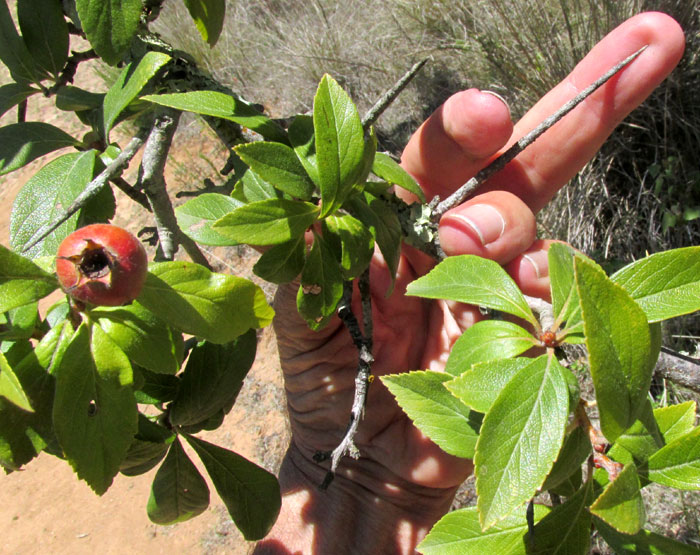Excerpts from Jim Conrad's
Naturalist Newsletter
entry from field notes dated April 15, 2022, taken in disturbed/reforesting borderline cloudforest within 1km of Valle de los Fantasmas, elevation ±2,320m (7600 ft), with limestone bedrock; about 40kms (24 miles), straight-line, ESE of San Luis Potosí, San Luis Potosí state, MÉXICO, (N22.06°, W100.62°)
MEXICAN HAWTHORN

During the driest part of the late dry season, beside a dirt road, a certain small tree, shown above, had managed to put on green leaves and flowers, and already the petals had fallen from the blossoms. Even without the white petals, with such leaves, flowers and fairly robust thorns, any northerner familiar with Temperate Zone trees would recognize this as a kind hawthorn, genus Crataegus, of the Rose Family. In the northern Temperate Zone the Rose Family is a big one, with around 230 hawthorn species alone, but down here the family is known mostly for its horticultural plants -- apples, pears, peaches, strawberries, blackberries, cherries, roses and such. In Mexico only about 15 hawthorn species are documented, and in this general area maybe three or four can be found.

Up north I've had hard times identifying hawthorns to species level, so if this species was to be figured out, I knew to document whatever the camera could catch. Above, you can see that the flower stems, or pedicels, are fairly long, and that they and the green parts destined to become the future fruits are uncommonly hairy.
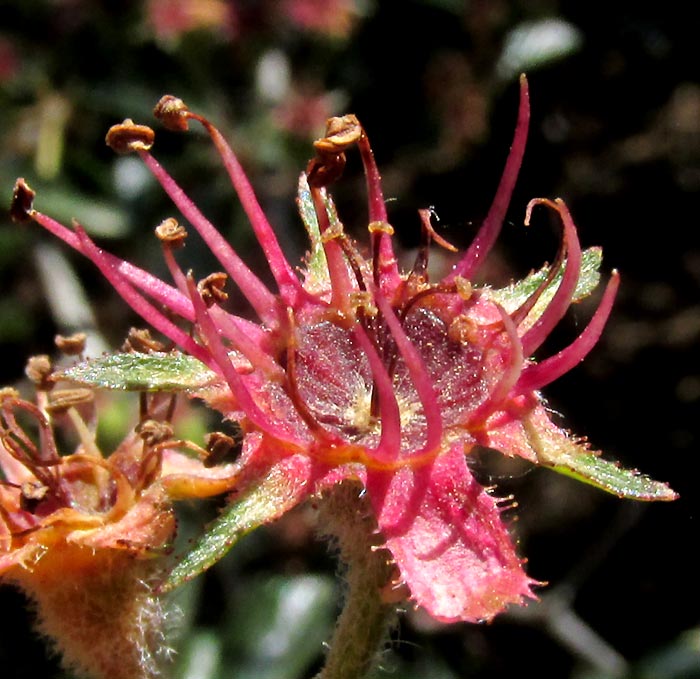
The petal-less flower shown above provides some good field marks. Notice the "stalked glands" along sepal margins. There are 5 styles and maybe 17 anthers. The flower is about 2cm wide (0.8 inch). Below are other important features:
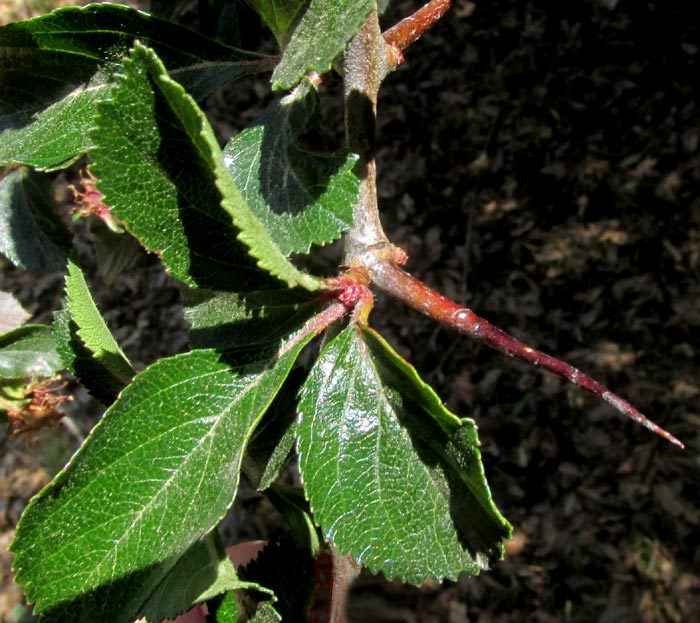
The thorn is longer and broader-based than on many other species. The leaf shape is fairly typical of hawthorn leaves, but note that the blades' upper surfaces are hairless and glossy. The picture below shows that leaf undersurfaces also are hairless except for small hairs along the veins. The young stems are exceedingly white-hairy.
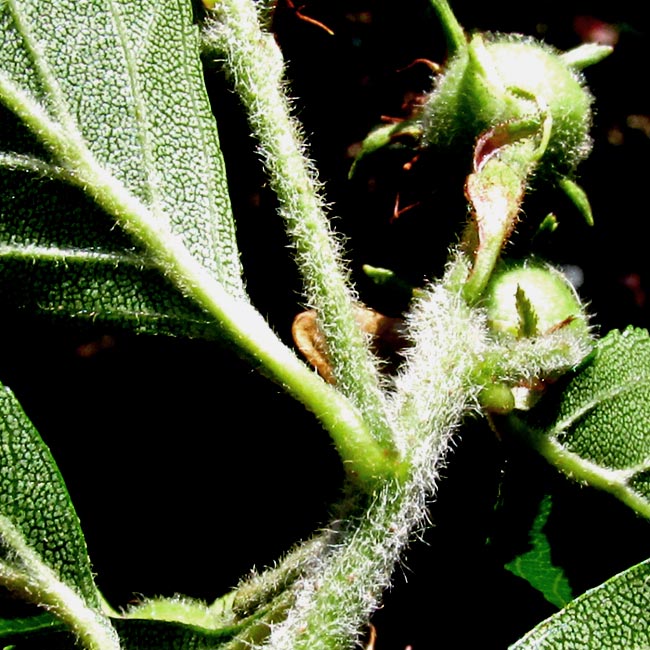
All these features lead us to the Mexican Hawthorn, CRATAEGUS MEXICANA. A lady met along the trail called the tree Manzanilla, and said that she like to eat the fruits.
Here in San Luis Potosí state we're at the northern boundary of Mexican Hawthorn's distribution. From here it continues in the highlands at 2000-2850m in elevation (6600-9300ft) south to Guatemala. Moreover, as a fruit tree it's often grown outside its native area. In various locations in South America, particularly the Andes, it's been "naturalized" as part of the local flora. In Mexico it's grown commercially, especially in Puebla state where, according to the Secretaría de Agricultura y Desarrollo Rural, in 2019, 5,336 tons of fruit were harvested.
Traditionally the tree has been used medicinally for a variety of ailments. Los corajes, or "the angers," was treated with a mixture of leaves and bark. Also it was deemed effective against diarrhea, amoebas, stomach ache, respiratory problems, weight loss, to improve the circulation, for heart flutter, and as a diuretic.
Entry dated November 10, 2023, from notes taken on ridge with secondary oak forest about 300m west of Cascadas de La Piedad waterfall 3kms NW of the community of San Pablo, municipality of Almeaco de Bonfil; N20.1002°, W100.0067°, elevation 2360 meters (7750ft); extreme southern Querétaro state, MÉXICO
MATURE FRUITS
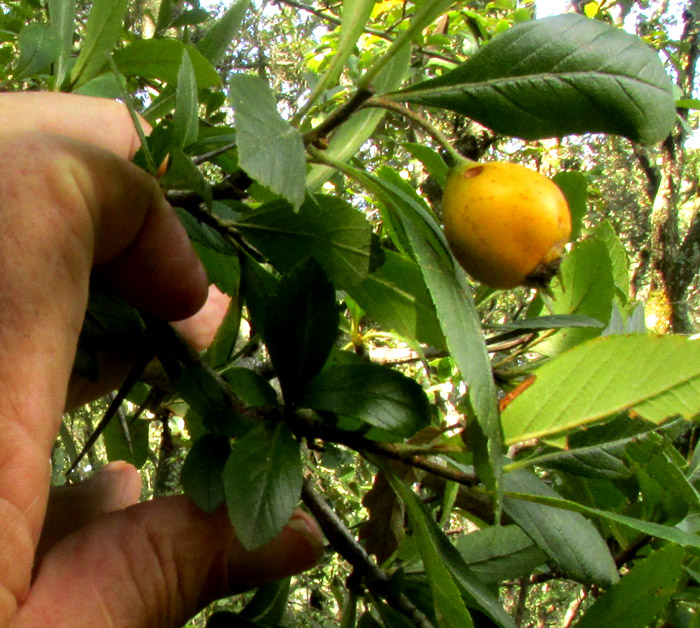
A young tree at the edge of a degraded oak forest and standing about 4.5m tall (15ft) bore several fruits like the one above. Two Mexican government pamphlets I've read about the production of these fruits, which refer to the fruits by the name of tejocotes, the Spanish name derived from the original Náhuatl name texocotl, meaning "hard and acidic." The pamphlets say that in Mexico the fruits are most famous as an ingredient of Christmas punch, to put in piñatas and for snacks. They're also used for producing liquors and sweets such as traditional ates and preserves. Little attention is given to eating them raw.
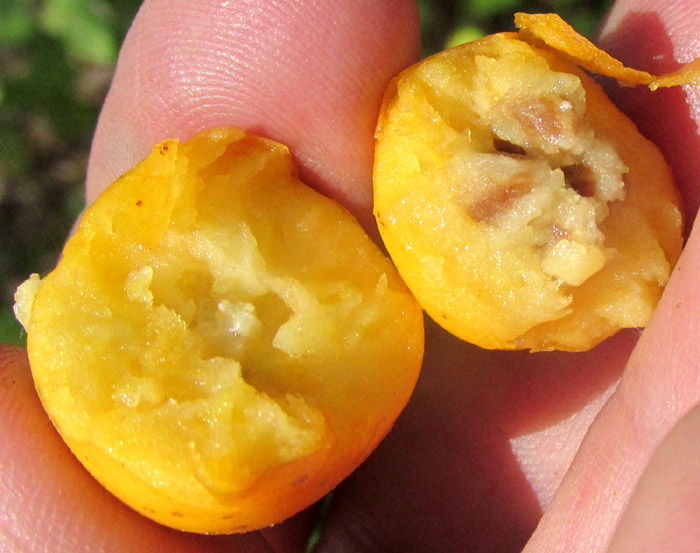
The fruits I ate were not at all hard and acidic. They were juicy-mealy, with their own robust and distinctive flavor, like old-time apple races before apples were commercialized just for sweetness, size, appearance and shippability. Possibly I was eating late-season fruits usually not harvested commercially because they might not ship well. But these little apples were delicious right off the tree -- much larger and better eating than any hawthorn fruits I've tasted in North America.
entry from field notes dated July 2, 2022, taken on the slopes of Cerro de la Cruz, elevation ~2700 (~8850 ft), rising on the south side of the community of El Pinar, Amealco de Bonfil, Querétaro, MÉXICO, (~N20.17°, ~W100.17°)
LONG THORNS
In an abandoned field a Mexican Hawthorn tree has been left by the firewood gatherers. Its thorns are longer than I've seen elsewhere, though I read in the Flora del Bajío that they can reach 6cm in length (2-1/3 inch):
